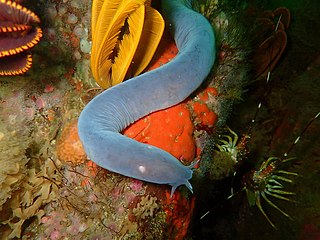
Hagfish, of the class Myxini and order Myxiniformes, are eel-shaped jawless fish. Hagfish are the only known living animals that have a skull but no vertebral column, although they do have rudimentary vertebrae. Hagfish are marine predators and scavengers who can defend themselves against other larger predators by releasing copious amounts of slime from mucous glands in their skin.

The spotted nutcracker, Eurasian nutcracker, or simply nutcracker is a passerine bird slightly larger than the Eurasian jay. It has a much larger bill and a slimmer looking head without any crest. The feathering over its body is predominantly chocolate brown with distinct white spots and streaks. The wings and upper tail are virtually black with a greenish-blue gloss.

Eptatretus springeri, the Gulf hagfish, is a bathydemersal vertebrate which lives primarily in the northeastern Gulf of Mexico. It has been observed feeding at and around brine pools: areas of high salinity which resemble lakes on the ocean floor that do not mix with the surrounding water due to difference in density. The high salt content, approximately 200 ppt compared to 35 ppt for standard seawater, creates a buoyant surface which renders oceanic submersibles unable to descend into the pool. It is believed that the inside of the pools only supports microbial life, while the majority of macroscopic life, such as methane-utilizing mussels, exists on the edges. The Gulf hagfish feeds on the primary producers of these environments, as well as other predators.

The broadgilled hagfish or New Zealand hagfish, also known by its Māori language name tuere, is a hagfish found around New Zealand and the Chatham Islands as well as around the south and east coasts of Australia, at depths between 1 and 900 metres.

The Pacific hagfish is a species of hagfish. It lives in the mesopelagic to abyssal Pacific ocean, near the ocean floor. It is a jawless fish and has a body plan that resembles early paleozoic fish. They are able to excrete prodigious amounts of slime in self-defense.

Eptatretus is a large genus of hagfish.
Eptatretus bischoffii is a common hagfish of the genus Eptatretus. Its maximum length is 55 centimetres (22 in). It lives in a demersal, non-migratory, marine habitat with its depth range between 8–50 m. It can survive in only temperate zones. These organisms are found in the South Pacific, mainly, Chile. It is harmless to humans.

Myxine glutinosa, known as the Atlantic hagfish in North America, and often simply as the hagfish in Europe, is a species of jawless fish of the genus Myxine.
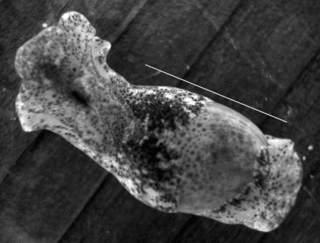
Haloa japonica, common name the Japanese bubble snail, is a species of sea snail or bubble snail, a marine opisthobranch gastropod mollusc in the family Haminoeidae, one of the families of bubble snails.
Nemamyxine is a genus of hagfish.
Rubicundus is a genus of hagfishes, the only member of the subfamily Rubicundinae. All species in it were formerly classified in Eptatretus. R. eos, R. lakeside, and R. rubicundus are known from single specimens caught in the Tasman Sea, Galápagos, and Taiwan, respectively. They are named after the distinctive red coloration that all species share.

Eptatretus hexatrema, the sixgill hagfish, or snotslang is a species of marine fish in the hagfish family of order Myxiniformes. It is native to the South Atlantic Ocean and southwestern Indian Ocean.

Eptatretus polytrema, the fourteen-gill hagfish or Chilean hagfish, is a demersal and non-migratory hagfish of the genus Eptatretus. It is found in muddy and rocky bottoms of the southeastern area of the Pacific Ocean near the coast of Chile between Coquimbo and Puerto Montt, at depths between 10 and 350 m. This hagfish can reach a length of 93 cm. It is only known from a few specimens and has not been recorded since 1988.
Solenaia is a genus of freshwater mussels, aquatic bivalve mollusks in the family Unionidae.

Moellendorffia is a gastropod mollusc genus of the family Camaenidae. Members of this genus appear only in East Asia, spanning north from Japan, Mainland China, Hong Kong, Vietnam and Indonesia.
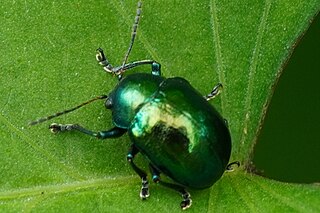
Colasposoma dauricum is a species of leaf beetle from eastern Asia. It was first described by Carl Gustaf Mannerheim in 1849. It is known as a pest of sweet potatoes.

Aplustrum amplustre, also known as royal paper bubble, ship’s flag shell, swollen bubble, is a species of sea snails, bubble snails, marine opisthobranch gastropod mollusks in the family Aplustridae.
Phintella abnormis is a spider species of the family Salticidae.
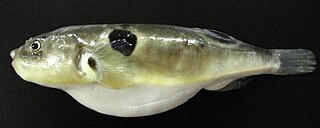
Takifugu obscurus or the obscure pufferfish is a species of euryhaline, anadromous pufferfish first described by T. Abe in 1949. It has been categorized by the IUCN as a least-concern species globally since 2014; in South Korea, it is however classified as an endangered species due to overfishing of its endemic populations. The Catalogue of Life lists no subspecies of Takifugu obscurus. The species prefers deeper, clearer areas of brackish and fresh water, and is found in estuaries, as well as rivers and tributaries thereof such as the South Korean rivers Geum, Han, and Imjin, or the Tamsui River. The species is endemic to North and South Korea, the Sea of Japan, and the East and South China Seas. Uses of Takifugu obscurus include human consumption, use in animal testing, and owning specimens as pets. As with most species of pufferfish, several organs of Takifugu obscurus contain tetrodotoxin, making it potentially poisonous if not prepared safely by trained persons.
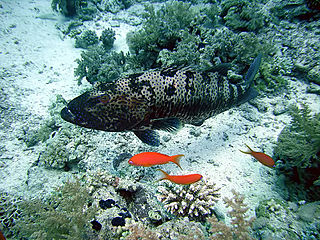
The squaretail coral grouper is a species of marine ray-finned fish. It is a grouper from the subfamily Epinephelinae, which is part of the family Serranidae. This family also includes anthias and sea basses. The squaretail coral grouper is also known as the spotted coral trout or the squaretail coral trout, and is fast-growing, short-lived, and early-maturing. However, due to the continued decrease in its population, it is now classified as vulnerable, as it continues to face threats from human activity.















